Engineering:LAV (armoured vehicle)
The Light Armoured Vehicle (LAV) is a series of vehicles built by General Dynamics Land Systems – Canada (GDLS-C), a London, Ontario based subsidiary of General Dynamics. First entering service in 1976, it has undergone a number of different upgrades and improvements over time which are denoted by different "marks" such as the LAV II, LAV III etc. It continues to form the backbone of the Canadian Army's combat vehicle fleet. The LAV series of vehicles exist in a number of different variants and are used in a number of different roles such as Armoured Fighting Vehicles, Infantry Fighting Vehicles, Armoured Engineer Vehicles, Command Posts, Ambulances, Repair and Recovery vehicles, etc.
LAV I
| LAV I | |
|---|---|
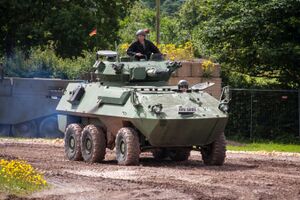 A surplus Cougar seen in a militaria event in the UK. | |
| Type | Armoured fighting vehicle |
| Place of origin | Canada |
| Service history | |
| In service | 1976–present |
| Used by | See Operators |
| Production history | |
| No. built | Cougar – 195[1] Grizzly – 274[1] Husky – 27[1][2] |
| Variants | See Variants |
| Specifications | |
| Mass | 10.7 t |
| Length | 5.97 m |
| Width | 2.50 m |
| Crew | Cougar: 3 (Commander, gunner and driver, 2 soldiers in rear of vehicle) Husky: 2 (Driver and technician) Grizzly: Commander, gunner and driver, 6 soldiers in rear |
Main armament | Cougar: 76 mm L23A1 gun (fires HESH, Smoke BE (base ejected), and Canister rounds)[3] Grizzly: 12.7mm heavy machine gun and a 7.62 mm machine-gun (C6) and 66 mm smoke grenade launchers (2 clusters of 4 launchers)[1] Husky: 7.62 mm machine gun (C6) and 66 mm smoke grenade launchers (2 clusters of 4 launchers)[2] |
Secondary armament | Cougar: 7.62 mm machine gun (C6) and 66 mm smoke grenade launchers No 12 (2 clusters of 4 launchers)[3] |
| Engine | 275 hp Detroit Diesel 6V53T two-cycle turbo-charged diesel |
| Suspension | 6×6 |
| Speed | 100 km/h |
The Armoured Vehicle General Purpose (AVGP) project led to the procurement of the first generation of the Light Armoured Vehicle (LAV I) vehicle and predominantly consisted of three variants ordered by the Canadian military in the 1970s entering service in 1974.[4][5][6][7] The AVGP variants were the Cougar armoured fighting vehicle, the Grizzly Armoured Personnel Carrier, and the Husky Armoured Recovery Vehicle which were all based on the six-wheeled version of the Switzerland MOWAG Piranha I.
The Canadian Army retired all AVGP variants beginning in 2005. However, a number of the retired vehicles were transferred to other militaries and police forces, where they continue to serve.[6][8]
The AVGP had propellers and trim vanes for amphibious use, like the eight-wheeled Bison, which was the vehicle family's immediate successor. The Canadian Army's LAV III, the United States Marine Corps' LAV-25, and the US Army's Stryker are other variants of the LAV family and directly evolved from the Canadian designs.
History

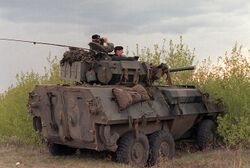
The AVGP variants were introduced into Canadian service in the late 1970s.[4] Intended for use only in Canada , they were pressed into service for several United Nations missions, including UNPROFOR and the mission to Somalia. One Grizzly was captured by Serb forces in the late 1990s, despite it being present on a peace keeping mission.[9]
The Cougar was used for training in Canada as an armoured fighting vehicle and informally labelled a "tank trainer".[5] During the 1980s and 1990s, it was used by armoured units as a fire support vehicle, for those units not equipped with the Leopard tank. The squadrons equipped with the Cougar in those regiments were humorously referred to as the "boat squadron" as opposed to the reconnaissance squadrons, which were equipped with the Lynx, and later the Coyote (another AVGP successor).
The Grizzly was used as an armoured personnel carrier in regular force infantry battalions not equipped with the M113 APC, and also by reserve units. The majority of vehicles had their marine propulsion systems removed. Under the Wheeled LAV Life Extension project, the Canadian Forces planned to convert Grizzly and Husky vehicles to support variants, such as Command Post and Mobile Repair Team Vehicle. However, the project was cancelled in 2005, and the vehicles retired.[6][7][10]
In May 2007, the Edmonton Police Service accepted the donation of a disarmed Grizzly from the Canadian Army.[11]
In March 2010, the Canadian Army donated two disarmed Cougar AVGPs to the Royal Canadian Mounted Police in British Columbia for use by the Emergency Response Team.[citation needed] They were retrofitted to transport ERT assault teams into hazardous areas where transport in unarmoured vehicles would not be safe.
In April 2014, the department of National Defence donated a Cougar AVGP to the Windsor Police Service in Windsor, Ontario.
Use in Africa
In June 2005, the Canadian government announced plans to loan 105 AVGPs (100 Grizzlys and 5 Huskys) to African peacekeepers in the Darfur region of Sudan.[12][13] The AVGP was considered sufficiently modern to be useful in this low-intensity conflict. Canada planned to arrange for civilian contractors to maintain these vehicles. As the vehicles contained some U.S.-manufactured or licensed parts, U.S. permission would be required to loan the vehicles. Initially, the vehicles were to be shipped without their Cadillac-Gage turrets. The vehicles arrived in Senegal in the late summer of 2005.[14][15]
The Sudanese government required various kinds of assurances before they would allow peacekeepers to use the vehicles in Sudan. On November 18, 2005 the vehicles started arriving in Sudan, in white livery, with their turrets.[16] The loan of vehicles for peace-keeping service in Sudan was originally for one year.[14][15]
However, the loan was extended, and transferred from the African Union to the United Nations. According to Amnesty International, the soldiers who used the loaned vehicles served in Sudan for too short a term to be properly trained and become experienced. One of the vehicles was destroyed by a rocket-propelled grenade.[14] A second vehicle was damaged when it rammed a more heavily armed, but unarmoured Technical vehicle.
Use in Uruguay
In 2008, the Uruguayan Army bought 44 surplus Cougars from the Canadian Army.[17][18] They were rebuilt without the turret by the Chilean MOWAG-Piranha builder FAMAE, as they will act as armoured personnel carriers for the UN deployment in the Republic of Congo (MONUC), and domestically.
In 2009, Uruguay bought 98 Grizzlys and 5 Huskys that were on loan with the AMIS/UNAMID mission in Darfur.[19] It's reported in the vehicles were placed under modernization under a contract with FAMAE since 2011 by installing new engines and gearboxes, as well as preventive maintenance to keep them in good condition.[19]
Variants
Variants of the AVGP are:[1]
Cougar
- Used as a tank trainer and Armoured Fighting Vehicle
- Three-soldier crew[5]
- Turret of a British Scorpion reconnaissance vehicle (76mm main gun)[5]
Grizzly
- Armoured personnel carrier (APC)[6]
- Three-soldier crew[6]
- Designed to carry a section of infantry[6]
- Mounting a Cadillac-Gage 1 metre turret, armed with a .50 BMG and a 7.62 mm machine gun[6][20]
Husky
- Armoured recovery vehicle (ARV)[7]
- Two-soldier crew[7]
- Designed to provide mechanical support for the other two vehicles[7]
Operators


Historical operators
 Canada (Canadian Army) - AVGPs were used by Regular and Reserve units, the Cougar in armoured regiments and the Grizzly in mechanized infantry battalions.
Canada (Canadian Army) - AVGPs were used by Regular and Reserve units, the Cougar in armoured regiments and the Grizzly in mechanized infantry battalions. Serbia - at least one Canadian Grizzly serving in the former Yugoslavia was captured by Serbian forces and had been photographed in the service of Jedinica za Specijalne Operacije (JSO, Special Operations Unit) or Crvene Beretke (Red Berets), a unit of the Serbian police.[21]
Serbia - at least one Canadian Grizzly serving in the former Yugoslavia was captured by Serbian forces and had been photographed in the service of Jedinica za Specijalne Operacije (JSO, Special Operations Unit) or Crvene Beretke (Red Berets), a unit of the Serbian police.[21]
Current operators
 Canada
Canada
- (Royal Canadian Mounted Police) – as the Tav 2 variant (Cougars modified for ERT tasks),[22] these were given for free by the Canadian Army to the RCMP in British Columbia in March 2010.[23][24]
- The Edmonton Police Service received one Grizzly in 2007.[25] It's used by the EPS' Tactical Section.[26]
- The New Glasgow Regional Police received one Grizzly in 2013.[27] Due to concerns that it's not being daily, the NGP is ready to hand it over to another police force that needs it as of 2017.[28]
- The Windsor Police Service received one Cougar in 2013.[23]
 Uruguay – 44 refurbished Cougars with turrets removed.[8] 98 Grizzlys and 5 Huskys given directly from the AMIS/UNAMID mission in Sudan.
Uruguay – 44 refurbished Cougars with turrets removed.[8] 98 Grizzlys and 5 Huskys given directly from the AMIS/UNAMID mission in Sudan.
Others
- African Union (AMIS mission) – 100 (−1 lost in combat) Grizzlys, 5 Huskys[29]
LAV II
| LAV II | |
|---|---|
 Canadian light armoured vehicle at the Calgary Stampede | |
| Type | Armoured car |
| Place of origin | Canada |
| Service history | |
| In service | 1990–present |
| Production history | |
| Designer | General Motors Diesel Division |
| Designed | 1988 |
| Specifications | |
| Mass | 14.4 t (15.9 short tons) |
| Length | 6.39 m (21.0 ft) |
| Width | 2.50 m (8.2 ft) |
| Height | 2.69 m (8.8 ft) |
| Crew | 2-4 (depending on variant) |
Main armament | 1 × M242 25mm chain gun with 1 × C6 7.62mm machine gun (coaxial)(Coyote variant only) |
Secondary armament | 1 × C6 7.62mm machine gun (pintle) 8 × grenade launchers (2 × cluster of 4) (all variants) |
| Engine | Detroit Diesel 6V53T 275hp |
| Suspension | 8×8 wheeled, 4× drive |
Operational range | 650 km (400 mi) |
| Speed | 100 km/h (62 mph) (land) 10 km/h (5.4 kn) (water) |
The LAV II is the second generation of the Light Armoured Vehicle (LAV) family moving from a 6x6 to a 8x8 platform, and was produced by General Motors Diesel Division (now General Dynamics Land Systems Canada) in London, Ontario. They were initially purchased and intended for operation by the Canadian Forces Primary Reserve, but were rapidly appropriated by the regular force of the Canadian Army.[30] It was procured in two main variants, the Coyote armoured fighting vehicle and the Bison armoured utility vehicle which filled a number of roles.
The Light Armoured Vehicle II (LAV II) Coyote has been in service from 1996 and was acquired for use in the light reconnaissance (scout) role,[31][32] although was also initially used as an armoured fighting vehicle in the role of medium tank trainer within armoured squadrons in the same way as the AVGP it replaced.[33] In service since 1996, the Coyote is a later generation of the LAV-25 and is of the same family and similar generation as the Bison APC and the Australian ASLAV.
Armament
The Coyotes mount a 25×137mm M242 Bushmaster chain gun and two 7.62×51mm NATO C6 general purpose machine guns.[31] One of the machine guns is mounted coaxial to the main gun while the other is pintle-mounted in front of the crew commander's hatch. The main gun is equipped with dual ammunition feeds that allow for separate weapons effects, selectable by the gunner/crew commander; the standard load is a belt of armour-piercing sabot rounds and a belt of HE-T explosive/fragmentation rounds. The main gun and coax machine gun are 2-axis stabilized. The turret is equipped with a laser rangefinder, but no ballistic computer; elevation and lead corrections are applied manually by the gunner using multi-stadia reticules in the day, thermal, and image intensification sights. The turret is also equipped with grenade dischargers that can be loaded with smoke and fragmentation grenades.
Mobility
The Coyote is powered by a Detroit Diesel 6V53T engine developing 400 horsepower (300 kW), and can reach speeds of 100 kilometres per hour (62 mph) (on road). The Coyote has a maximum road range of 660 kilometres (410 mi). It uses a larger wheel than initially used on the Bison and AVGP (these vehicles were later retrofitted with this wheel). Compared to the later LAV-III family of vehicles, the Coyote is smaller, uses smaller wheels and tires, has a "sharp" rather than "rounded" nose profile, and has a smaller, oval driver's hatch. Like the LAV-III, the Coyote can be fitted with additional ceramic bolt-on armour panels for increased protection. The Coyote can be transported on a Hercules C-130 plane but the turret needs first to be removed.[34]
Sub-variants

Coyotes come in three variants: Command, Mast, and Remote. The Mast and Remote variants have a sophisticated suite of electronic surveillance equipment including radar, video, and infrared surveillance night vision devices. The mast variant has this equipment mounted on a 10-metre telescoping mast that can be extended to raise the surveillance suite out from behind cover. The remote variant of the Coyote has its surveillance suite mounted on two short tripods, which crew can deploy remotely using a 200-metre spool of cable.
When first purchased, the Coyote was designated for service with both the Regular Force and Reserve Force, with the Mast variants earmarked for the Regular units and the Remotes designated for the Reserves. Shortly after taking delivery of the vehicles, but before they were assigned to the Reserve units, all Coyotes were reassigned to the Regular Force.
Service history
Since the introduction of the Coyote to the Canadian Armed Forces, the vehicle has served national interest domestically and abroad. The Coyote served during the United Nations/ NATO missions in Bosnia and Herzegovina, Macedonia, Kosovo, and in Afghanistan. Domestically, it has been deployed during "Operation Grizzly" to Kananaskis to secure the 28th G8 summit, the 36th G8 summit, and the G-20 Toronto summit,[35][36] in addition to a number of domestic emergency response incidents. The Coyote is currently being retired and is being replaced by a mix of TAPV and LAV VI armoured vehicles.
The LAV II Bison is an armoured vehicle based on the 8x8 LAV-25 platform and was originally designed as an armoured personnel carrier. Entering service in 1990, it was used mainly as an armoured utility vehicle having a number of different sub-variants throughout its years of service.
Design
By starting with a basic LAV-25, the Bison design process took only 7 days.[37] The Bison differs from the baseline LAV-25 by raising the height of the roof, removing the turret ring, placing a commander's cupola behind the driver, and incorporating a rail mount system in the cargo/passenger compartment to quickly change mission specific equipment. The driver is seated in the front-left of the crew compartment. The commander has a slightly raised position directly behind the driver with access to his own hatch and mounted machine gun. The engine is to the right of the crew compartment.
The Canadian Forces began upgrading the Bison between 2002 and 2008. The upgrades include improved engine power, new torsion bars, fittings for add-on armour, air conditioning, and the VRS respirator system for NBC defence.[38]
Sub-variants
The Bison's rail mount system allows it to be adapted to a variety of roles without any major modifications. Bisons used by the Canadian Forces have been adapted for use as armoured personnel carriers (original configuration - mostly replaced in this role by the LAV III), 81mm mortar carriers, ambulances (32), Mobile Repair Team (MRT) vehicles (32), Armoured recovery vehicles (32), electronic warfare vehicles (25), and NBC reconnaissance vehicles (4).
Current operators
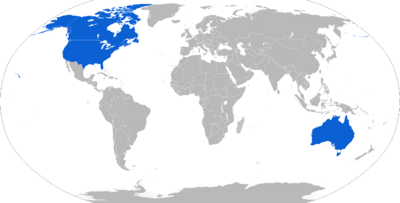
- Australian Army - 97[37] (See ASLAV Type II)
- Canadian Army - 199[37] (being phased out and replaced by LAV VI variants)
- US National Guard - 12[37]
LAV III
| Light Armoured Vehicle III | |
|---|---|
 A New Zealand Army LAV III in Afghanistan | |
| Type | Infantry Fighting Vehicle |
| Place of origin | Canada |
| Service history | |
| Used by | See Operators |
| Wars | See Service history |
| Specifications | |
| Mass | 16.95 t |
| Length | 6.98 m (22 ft 11 in) |
| Width | 2.7 m (8 ft 10 in) |
| Height | 2.8 m (9 ft 2 in) |
| Crew | 3 (+ 6 or 7 passengers) |
Main armament | 1 × M242 25 mm chain gun with TIS |
Secondary armament | 1 × C6 7.62 mm machine gun (coaxial) 1 × C9A2 5.56 mm or C6 7.62 mm machine gun (pintle mount) |
| Engine | Caterpillar 3126 diesel 260 kW (350 hp) |
| Suspension | Hydropneumatic |
Operational range | 450 km (280 mi) |
| Speed | 100 km/h (62 mph) |
The LAV III, an infantry fighting vehicle variant originally named the Kodiak by the Canadian Army, is the third generation of the Light Armoured Vehicle (LAV) family of armoured vehicles and first entered service in 1999.[39][40] It was developed in Canada from the LAV II and Bison variants and is the primary mechanized infantry vehicle of the New Zealand Army and formerly of the Canadian Army.[39] It also forms the basis of the Stryker vehicle used by the US Army and other operators.
Development
By July 1991, the Canadian Armed Forces had identified the need to replace their aging fleet of 1960s and 1970s era armoured personnel carriers. As a result, $2.8 billion was earmarked for the Multi-Role Combat Vehicle (MRCV) project by the sitting Conservative government. The mandate of the MRCV project was to provide a series of vehicles based on a common chassis which would replace the M113 armored personnel carrier, Lynx reconnaissance vehicle, Grizzly armoured personnel carrier, and Bison armoured personnel carrier. The project was, however, deemed unaffordable and cancelled by March 1992.[41]
By 1994, after the Liberal Party had returned to government, the army was still in need of new vehicles. As a result, the army embarked on the Light Armoured Vehicle Project, which would adapt parts of the MRCV Project, and be implemented incrementally to spread out the costs. Also, the requirement to replace the Bisons was dropped. The first phase of the project saw the selection of the Coyote Reconnaissance Vehicle to replace the Lynx.
On August 16, 1995, it was announced that General Motors Diesel Division (later renamed GM Defense, and subsequently purchased by General Dynamics Land Systems of London, Ontario) had been awarded the contract to produce the LAV III which would replace the Grizzly and a large portion of the M113 armoured personnel carriers.[41] The LAV III would incorporate the turret and weapon system used with the Coyote (which was produced at the same location).
Design
Mobility
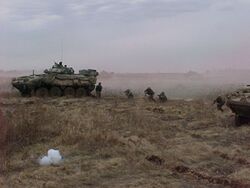
The LAV III is powered by a Caterpillar 3126 diesel engine developing 350 horsepower (260 kW) and can reach speeds above 100 kilometres per hour.[42] The vehicle is fitted with 8x8 drive and also equipped with a central tire inflation system, which allows it to adjust to different terrain, including off-road.[43][44] The LAV III is fitted with a modern anti-locking brake system (ABS). Unlike earlier versions of the LAV, the LAV III does not have amphibious capabilities.
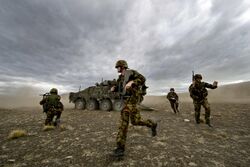
The LAV III faces the same concerns that most other wheeled military vehicles face. Like all wheeled armoured vehicles, the LAV III's ground pressure is inherently higher than a tracked vehicle with a comparable weight. This is because tires will have less surface area in contact with the ground when compared to a tracked vehicle. Higher ground pressure results in an increased likelihood of sinking into soft terrain such as mud, snow and sand, leading to the vehicle becoming stuck. The lower ground pressure and improved traction offered by tracked vehicles also gives them an advantage over vehicles like the LAV III when it comes to managing slopes, trenches, and other obstacles.
The LAV III can somewhat compensate for these effects by deflating its tires slightly, meaning that the surface area in contact with the ground increases, and the ground pressure is slightly lowered.
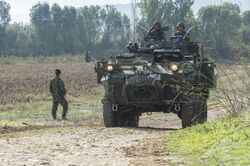
However, wheels offer several advantages over tracked vehicles, including lower maintenance for both the vehicle and road infrastructure, quieter movement for improved stealth, greater speed over good terrain, and higher ground clearance. Wheeled vehicle crews are also more likely to survive mine or IED attacks than the crew of a similarly armoured tracked vehicle.
The LAV III's turret gives the vehicle a higher centre of gravity than the vehicle was initially designed for. This has led to concerns that the vehicle is more likely to roll over on uneven terrain.
While there have been several recorded rollovers (about 16),[45] the most common cause was found to be unstable terrain, specifically road shoulders unexpectedly giving away beneath the vehicle.[46] The weight balance of the LAV III is taken into consideration during driver training, largely mitigating the chances of a rollover. It is considered one of the safest and most well-rounded vehicles of its kind in the world.
Protection

The basic armour of the LAV III, covering the Standardization Agreement STANAG 4569 level III, which provides all-round protection against 7.62×51mm NATO small calibre rounds. A ceramic appliqué armour (MEXAS) can be added, which protects against 14.5×114mm heavy calibre rounds from 500 meters. In December 2008 the Government of Canada awarded EODC Engineering, Developing and Licensing Inc. C$81.5 million worth of contracts to provide for add-on-armour kits, modules and spares for its LAV III wheeled armoured personnel carriers.[47][48] This armour kit is intended to provide increased protection against improvised explosive devices (IED), explosively formed penetrators and 30 mm caliber armour piercing rounds.[47][49][50][51][40][52] The LAV III can be also fitted with cage armour, which provides protection against shaped charges. The LAV III is fitted with a nuclear, biological, chemical (NBC) filtration system accompanied with a GID-3 chemical detector and AN/VDR-2 radiation detector systems.[53] The LAV III was designed to produce a very low and very compact structure to minimize radar and IR-signatures. The LAV III also uses heat-absorbing filters to provide temporary protection against thermal imaging (TIS), image intensifiers and infrared cameras (IR). General Dynamics is in the process of integrating the LAV III with an active protection system[54] based on the Israeli Trophy system.[55]
The majority of Canadian casualties in Afghanistan have occurred during a patrol aboard a LAV III.[56] This can be explained by the fact that the LAV III is the most commonly used Canadian armoured personnel carrier in theatre, and simply represents a normal association between use and likelihood to encounter a mine or improvised explosive device.[57] The LAV III offers comparable or better protection than most other infantry carriers used in Afghanistan. In an effort to improve protection as a result of experiences in Afghanistan, future LAV III upgrades will likely include improved mine and IED protection.[58]
Armament
The LAV III is fitted with a two-man turret, armed with the M242 Bushmaster 25 mm caliber chain gun and a coaxial 7.62-mm machine gun. One more 5.56 mm or 7.62 mm machine guns is positioned on top of the turret. The LAV III also has eight 76-mm grenade launchers in two clusters of four launchers positioned on each side of the turret. The grenade launchers are intended for smoke grenades.[42] In 2009, a number of LAV III's were modified with a Nanuk remotely controlled weapon station (RCWS) to provide better protection and to increase the chances of survival of the crew against improvised explosive devices and anti-tank mine threats on the battlefield.[59]
Sights
The LAV III is equipped with a daytime optical Thermal Imaging System (TIS) and Generation III Image Intensification (II). The LAV III is equipped with a Tactical Navigation System (TacNav) to assist in navigation and target location tasks. The LAV III is equipped with an LCD monitor directly connected to the vehicle's external cameras, providing real-time images of the battlefield for the passengers.[42]
Service history
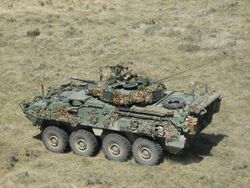
The LAV III and related versions have been used in the following:
- United Nations Mission in Ethiopia and Eritrea (UNMEE)
- United Nations Mission in Kosovo (UNMIK)
- United Nations Mission in Bosnia and Herzegovina (UNMIBH)
- United Nations Mission in Haiti (UNMIH)
- War in Afghanistan (ISAF)
- Napier shootings
- Operation Lotus
- Response to the 2011 Christchurch earthquake
- Colombian armed conflict
New Zealand
The New Zealand armed forces purchased 105 LAV of which 102 were standard vehicles and 3 were redesigned for recovery.
In May 2009, two NZLAVs were deployed to support police during the Napier shootings. They protected specialist police while retrieving the body of a deceased police officer from outside the offender's residence.
In November 2009, it was announced that three NZLAVs would be deployed to assist NZSAS operations in Afghanistan and they were up-armoured.[60] In 2011, these three LAVs were moved to Bamyan to support the provincial reconstruction team there as they were no longer needed in Kabul due to reduced SAS numbers. Five additional LAVs were also flown to Bamyan. One has since been damaged by a roadside bomb. In May 2012, the New Zealand government announced that it may leave all these LAVs behind in Afghanistan for use by local forces when the New Zealand forces leave in 2013.[citation needed] As of November 2013, all of these deployed LAVs had been returned to New Zealand.
In 2011, after the Christchurch earthquake, LAVs from Burnham Camp were deployed to assist police with securing the inner city during the nights.
In March 2016, two LAVs were deployed to assist with lifting a siege near Kawerau in the Bay of Plenty after four policemen were shot at and severely injured.[61]
Sub-variants
- TOW Under Armour (TUA) – Standard LAV III turret replaced with TOW Under Armour launcher for anti-tank purposes
- Infantry Section Carrier (ISC) – Surplus LAV TUA hulls fitted with a Nanuk Remotely Controlled Weapon Station.
- Observation Post Vehicle (OPV) – Standard LAV III equipped for use by forward observation officer (FOO).
- Command Post Vehicle (CPV) – Standard LAV III equipped for command post duties.
- Engineer LAV (ELAV) – LAV III equipped with a dozer blade and other engineering equipment.[62]
- Infantry Mobility Vehicle (IMV) – Standard NZLAV vehicle used in cavalry, reconnaissance, and forward observer roles.
- Light Obstacle Blade (LOB) – An NZLAV IMV fitted with a small blade for minor earth works and clearing of obstacles.
- Recovery (LAV-R) – NZLAV vehicle fitted with a TR200 winch and earth anchor for recovery operations.
- Multi-Mission Effects Vehicle (MMEV) – The project was canceled in 2005
- Light Armoured Vehicle Reconnaissance Surveillance System (LRSS) – Will replace the Coyote Reconnaissance Vehicle with 66 LAV VI chassis by 2021.
- Armoured Combat Support Vehicle (ACSV) - 360 LAV VI based ACSV will replace the current fleets of LAV II Bison and TLAV (M113).
Operators
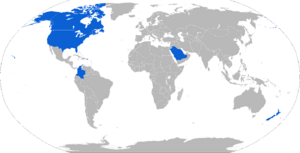

 Canada
Canada
- Canadian Army – formally operated 651,[39][42] but since phased out by LAV VI
- 2017 February 10, Canadian defence minister Harjit Sajjan announced a CAD$404 million (USD$309 million) investment to upgrade the chassis of an additional 141 light armoured vehicles (LAVs). The upgrade will increase the LAVs' mobility, protection, and information management systems.[63][64]
 New Zealand
New Zealand
- New Zealand Army – 105 NZLAVs[39]
 Saudi Arabia
Saudi Arabia
- Saudi Arabian National Guard – 19[39]
- Saudi Arabia will receive 900 modified LAV-III, known as the LAV VI (marketed as the LAV "6.0"), for 15 billion dollars.[65] Some of the 900 combat vehicles will be fitted with an autoloading 105 mm anti-tank gun, known as the Cockerill CT-CV 105HP Weapon System (gun and turret). This weapon can also fire a Falarick 105 missile, which can hit a target at distances up to 5,000 m and can perforate up to 550 mm of armour. The rest will be fitted with a CPWS 20-25-30, which can be armed from a 20 mm to a 30 mm autocanon and 150 ready to fire munition.[66][67]
 Colombia
Colombia
- Colombian Army – 32
- On December 27, 2012, the Colombian Army selected the LAV III to equip its mechanized infantry units. The vehicles are on order from General Dynamics Land Systems to partially replace their M113s and gradually replace the EE-11 Urutu. They will be armed with the Samson RWS with M2 Browning machine guns or 25 or 30 mm cannons.[68] The contract was officially signed on January 10, 2013 for the order of 24 vehicles worth $65.3 million. They will have the double v-hull design and add-on armor to provide protection against mine blasts, IEDs, and other threats. Deliveries are to be completed by May 2014.[69] Colombia is considering ordering 9–12 more vehicles.[70] 8 LAV IIIs were acquired in January 2014.[71]
 United States
United States
- U.S. Army – The US army operates LAV III derived Stryker ACV, ordered from General Dynamics Land Systems Canada in 2000, with delivery of 4,466 completing in 2014.
 Thailand
Thailand
- Royal Thai Army – In May 2019 Royal Thai Army ordered 37 refurbished LAV-III derived M1126 Infantry Carrier Vehicles from U.S. Army and will also receive 23 more M1126 vehicles.[72] Around 60 Strykers were delivered to Bangkok via C-17s with an option to include 30 more Strykers free of charge while Thai military personnel will be trained in the US to learn about operating the vehicles.[73]
Retired LAV III on display
- Highway of Heroes Durham LAV Monument in Bowmanville, Ontario – a retired Canadian Army LAV III located at Clarington Fields honouring 162 deaths and 40,000 Canadians who served in Afghanistan from 2001 to 2011.[74]
- The Afghanistan Repatriation Memorial in Trenton, Ontario – a retired Canadian Army LAV III was dedicated on September 15, 2016, to honour the approximately 40,000 Canadian Forces personnel who served and the 162 Canadians who died in the cause of bringing peace and freedom to the people of Afghanistan.[75]
- The LAV III Monument at the Seaforth Armoury in Vancouver, dedicated May 6, 2017, honours the 500 or so members of 39 Canadian Brigade—especially the two who died—who served in Afghanistan.[76]
- The Hamilton / Afghanistan War Monument – in Hamilton, Ontario – a retired Canadian Army LAV III located at the Canadian Warplane Heritage Museum was dedicated on June 3, 2017 to honour the service and sacrifice of the Hamilton area soldiers, sailors and aircrew who served in Afghanistan.[77]
- The LAV III Monument at Fort York Armoury in Toronto, Ontario. A decommissioned Canadian Army LAV III was dedicated on June 10, 2018, to honour the 40,000 Canadian Armed Forces (CAF) who served and the 162 Canadians who lost their lives during the conflict in Afghanistan.[78]
- The B.C. Regiment (DCO) LAV III Monument at Shiloh Hill, Mission, B.C. was dedicated July 12, 2019 to commemorate the Canadian Mission 2001 - 2014 in Afghanistan. The ceremony held by B.C.R. Honoraries and members of the military community in attendance. ref. The British Columbia Regiment (DCO) Association -Home and Newsletter.
- The LAV III Monument at Parc de la Paix (Peace Parc) in Rivière-à-Claude, Gaspésie, Québec. A decommissioned Canadian Army LAV III dedicated on August 19, 2019 honouring 40,000 Canadian Armed Forces (CAF) who served and the 162 Canadians who lost their lives during the conflict in Afghanistan.[79]
- The Ontario Regiment RCAC Museum in Oshawa, Ontario has an operational LA|V III as part of its collection of over 100 operating historical military vehicles..
LAV VI
The LAV VI is the fourth generation of the Light Armoured Vehicle (LAV) family of armoured vehicles based on the LAV III first entering service in 2013. The Canadian Army plans to replace its entire LAV fleet of various LAV II and LAV III variants with the LAV VI. The vehicle is being acquired in two main variants: a fighting vehicle equipped with the 25mm cannon seen on the LAV II and LAV III, and a support variant labelled the Armoured Combat Support Vehicle (ACSV).
History
In July 2009, the Canadian Department of National Defence announced that $5 billion would be spent to enhance, replace and repair the army's armoured vehicles. Part of the spending would be used to replace and repair damaged LAV III's due to wear and tear from operations in Afghanistan. As much as 33 percent of the army's light armoured vehicles were out of service.[80] Furthermore, the LAV III's will be upgraded with improved protection and automotive components.[81] The Canadian Armed Forces has lost over 34 vehicles and 359 were damaged during the mission in Afghanistan. The Canadian army has lost 13 LAVs and more than 159 were damaged by roadside bombs or enemy fire.[82] Of the $5 billion announced, approximately 20% of it will be used to upgrade LAV III models. The upgrade will extend the LAV III life span to 2035. The remaining $4 billion is to be spent on a "new family of land combat vehicles".[83] The Department of National Defence considered the purchase of vehicles meant to accompany the Leopard 2 and to sustain the LAV III into combat. The CV90, the Puma (IFV) and the Véhicule blindé de combat d'infanterie were the most likely candidates for the role. A contract of 108 with an option for up to 30 more was considered,[84][85][86] but a combination of budget cuts and upgrades to the existing fleet of LAV IIIs have led the Canadian Army to cancel its order for 108 CV90s.[87]
On October 21, 2011, the Canadian government announced a $1.1 billion contract to General Dynamics Land Systems to upgrade 550 LAV III combat vehicles. The government said the upgrade is needed to improve protection against mines and improvised explosive devices (IEDs), which have been the cause of a number of Canadian deaths in Afghanistan. The improvements will also extend the service of the vehicles up to 2035 and will boost troop mobility.[88][89][90] The upgrades include a new and more powerful engine, increased armour protection, steering and brake systems. The turret hatches on the LAV III would be made larger and improved fire control, thermal, day and low-light sights, and data displays. The weight of the vehicle would increase from 38,000 pounds (17,000 kg) to 55,000 pounds (25,000 kg).[91][92] The first of 66 upgraded LAV IIIs was delivered on February 1, 2013.[93] The success of the upgrade program and budget pressures led to the cancellation of the Close Combat Vehicle replacement program later that year.[94]
In September 2012, the original contract valued to at $1.064 billion to upgrade the 550 LAV III's variants, an infantry section carrier, a command post, an observation post and an engineer vehicle to the LAV VI configuration, was modified. This included an additional $151 million to upgrade 66 LAV III's to the LAV VI with a LAV Reconnaissance and Surveillance System (LRSS) fitted.[95]
On February 10, 2017, General Dynamics Land Systems – Canada of London, Ontario, was awarded a $404 million order to work on 141 LAV Operational Requirement Integration Task (LORIT) vehicles. This contract will upgrade the remaining LAV III fleet in the Canadian Army to the LAV VI configuration. This brings the Canadian Army's Light Armoured Vehicle III Upgrade (LAVUP) program to a total cost of $1.8 billion.[63]
Final completion and delivery of the Canadian Army's Light Armoured Vehicle III Upgrade (LAVUP) to upgrade the LAV III to the LAV VI was expected to be completed by December 2019.[64]
On August 16, 2019, the Government of Canada announced its intention to purchase up to 360 Armoured Combat Support Vehicles (ACSVs), and that negotiations with General Dynamics Land Systems Canada had entered the final stages. Based heavily on the LAV 6.0/VI platform, the ACSVs will replace the Bison LAV and the M113 Tracked LAV fleets of the Canadian Armed Forces.[96]
On September 5, 2019, Public Services and Procurement Canada on behalf of the Department of National Defence awarded General Dynamics Land Systems Canada a CAD$2 Billion contract for 360 ACSVs, initial spare parts, manuals, training, and various vehicle add-on kits. The various add-on kits incorporated in the procurement include: add-on armour, mine blast & enhanced crew protection, laser warning systems, side protection and remote weapons station kits. The Department of National Defence stated that by procuring similar combat support vehicles in the CAF fleet offers the advantages of reduced training and sustainment costs, in addition to the availability of standard spare parts to fix vehicles quickly during critical operations. The vehicles are expected to support a wide range of operations, including domestic disaster relief and overseas peacekeeping missions. Subsequently, the ACSV will be available in eight variants to provide services such as: ambulances, vehicle recovery, engineering, mobile repair, electronic warfare, troop-carrying, and mobile command posts.[97] Delivery of the first set of vehicles is expected in late 2020, with the last vehicles being delivered in 2025.[96]
On May 25, 2020, Kongsberg Defence & Aerospace announced that they had signed a contract worth NOK500 Million (CAD$73.6 Million) with General Dynamics Land Systems - Canada for delivery of the newest generation of Protector Remote Weapons Stations (or RWS) to the Canadian Army. The Protector RWS is to be equipped on Canada's fleet of ACSVs.[98] It was subsequently announced on June 1, 2020, that delivery of the first ACSVs was still on schedule for late 2020 and would not be delayed in spite of the COVID-19 pandemic.[99]
Related vehicles
References
- ↑ 1.0 1.1 1.2 1.3 1.4 "Grizzly AVGP". Department of National Defence. http://www.army.forces.gc.ca/lf/English/2_display.asp?product=71&more=71.
- ↑ 2.0 2.1 "Husky". Department of National Defence. http://www.army.forces.gc.ca/lf/English/2_display.asp?product=62&more=62.
- ↑ 3.0 3.1 "Cougar". Department of National Defence. http://www.army.forces.gc.ca/lf/English/2_display.asp?product=57&more=57.
- ↑ 4.0 4.1 "Background – Armoured Vehicle, General Purpose – 6x6 AVGPs". Canadian American Strategic Review. September 2009. http://www.casr.ca/bg-army-armour-avgp-lav.htm.
- ↑ 5.0 5.1 5.2 5.3 "Background – Armoured Vehicle, General Purpose – Cougar DFSV". Canadian American Strategic Review. September 2009. http://www.casr.ca/bg-army-armour-avgp-cougar.htm.
- ↑ 6.0 6.1 6.2 6.3 6.4 6.5 6.6 "Background – Armoured Vehicle, General Purpose – the Grizzly ISC". Canadian American Strategic Review. September 2009. http://www.casr.ca/bg-army-armour-avgp-grizzly.htm.
- ↑ 7.0 7.1 7.2 7.3 7.4 "Background – Armoured Vehicle, General Purpose – the Husky ARV". Canadian American Strategic Review. September 2009. http://www.casr.ca/bg-army-armour-avgp-husky.htm.
- ↑ 8.0 8.1 "AVGPs and the Wheeled LAV Life Extension Project". Canadian American Strategic Review. http://www.casr.ca/bg-army-armour-avgp-wlav-le.htm.
- ↑ Frank Kuschnereit. "Photos of vehicle". http://kuschnereit.net/lostgriz.html.
- ↑ "Archived copy". http://www.army.forces.gc.ca/lf/english/11_6_3.asp.
- ↑ "Tactical". Edmonton Police Service. http://www.edmontonpolice.ca/home/communitypolicing/operationalservices/tactical.aspx.
- ↑ "Canadian tanks muscle AU forces". Sudan Tribune. 2005-11-21. http://www.sudantribune.com/spip.php?article12669.
- ↑ "Background — CF AVGPs for the African Union Mission in Sudan". Canadian American Strategic Review. http://www.casr.ca/bg-sudan.htm.
- ↑ 14.0 14.1 14.2 "Background — AVGPs in Africa — Grizzlys and Huskys for Darfur". Canadian American Strategic Review. October 2009. http://www.casr.ca/bg-army-armour-avgp-darfur.htm.
- ↑ 15.0 15.1 "UNAMID UPDATE: TIME FOR EFFECTIVE ACTION". Amnesty International. 2008-02-07. http://www.amnestyusa.org/document.php?lang=e&id=ENGAFR540072008.
- ↑ "Armoured vehicles approved for Sudan". https://www.theglobeandmail.com/news/world/armoured-vehicles-approved-for-sudan/article22506799/.
- ↑ "Pan American Defence Online" (in es). http://panamericandefense.com/2008/12/10/lav-uruguay/.
- ↑ "Background – AVGPs and the Wheeled LAV Life Extension Project". Canadian American Strategic Review. October 2009. http://www.casr.ca/bg-army-armour-avgp-wlav-le.htm.
- ↑ 19.0 19.1 "Archived copy". https://www.defensa.com/uruguay/ejercito-uruguayo-pone-punto-blindados-mowag-husky-grizzly.
- ↑ "Cadillac Gage 1-Meter Crewed Turret". Canadian American Strategic Review. http://www.casr.ca/101-army-armour-1m-turret.htm.
- ↑ "canadiansoldiers.com". https://www.canadiansoldiers.com/vehicles/avgp/avgp.htm.
- ↑ "Mounties unveil crime fighting 'tank'". March 24, 2010. https://bc.ctvnews.ca/mounties-unveil-crime-fighting-tank-1.495082.
- ↑ 23.0 23.1 "Check Out Canadian Cops' New Toy". August 28, 2014. https://www.huffingtonpost.ca/2014/08/28/windsor-police-cougar-military-vehicle_n_5726492.html.
- ↑ "Archived copy". https://o.canada.com/news/national/canadian-police-forces-bulking-up-with-armoured-vehicles/comment-page-1.
- ↑ "'For public and officer safety': Edmonton city police mum on possibility of third armoured vehicle". https://edmontonjournal.com/news/local-news/for-public-and-officer-safety-edmonton-city-police-mum-on-possibility-of-third-armoured-vehicle.
- ↑ https://www.edmontonpolice.ca/CommunityPolicing/OperationalServices/Tactical
- ↑ "Do New Glasgow cops really need Cougars?". March 5, 2013. https://atlantic.ctvnews.ca/do-new-glasgow-cops-really-need-cougars-1.1182919.
- ↑ "Archived copy". https://www.cbc.ca/news/canada/nova-scotia/new-glasgow-police-cougar-light-armoured-vehicle-gift-halifax-1.4138028.
- ↑ "AVGPs in Africa — Grizzlys and Huskys for Darfur". Canadian American Strategic Review. http://www.casr.ca/bg-army-armour-avgp-darfur.htm.
- ↑ "Bison Mobile Repair Team vehicle delivered to CF" (Press release). Department of National Defence (Canada). 2009-05-26. Retrieved 2009-07-27.[yes|permanent dead link|dead link}}]
- ↑ 31.0 31.1 "Exploring the Coyote". Department of National Defence. http://www.dnd.ca/menu/coyote/.
- ↑ "Vetronics Engineering". General Dynamics Canada. http://www.gdcanada.com/content/detail.cfm?acronym=vetronics.
- ↑ Marteinson, John; McNorgan,Michael R. (2000). The Royal Canadian Armoured Corps: An Illustrated History. Montreal: Robin Brass Studio. ISBN 978-1896941172.
- ↑ Barry Cooper, Mercedes Stephenson, Ray Szeto (2004). "Canada's Military Posture: An Analysis of Recent Civilian Reports". The Fraser Institute. http://www.fraserinstitute.org/COMMERCE.WEB/product_files/CanadaMilitaryPosture.pdf.
- ↑ Barr, Colonel David."The Kananaskis G8 Summit: A Case Study in Interagency Cooperation." journal.forces.gc.ca, 14 July 2008. Retrieved: 5 June 2010.
- ↑ Barr, Colonel David."Mosquitoes could be Huntsville weapon against protesters" thestar.com, 22 June 2010. Retrieved: 23 June 2010.
- ↑ 37.0 37.1 37.2 37.3 "Bison Armoured Personnel Carrier". Military-Today.com. http://www.military-today.com/apc/bison.htm.
- ↑ "Canadian Army > Bison Armoured Vehicle". Department of National Defence (Canada). http://www.army.forces.gc.ca/land-terre/equipment-equipement/item-eng.asp?product=140.[yes|permanent dead link|dead link}}]
- ↑ 39.0 39.1 39.2 39.3 39.4 "LAV III/NZLAV". Deagel.com. http://www.deagel.com/Wheeled-Armored-Fighting-Vehicles/LAV-III_a000316001.aspx.
- ↑ 40.0 40.1 "LAV III Kodiak Armoured Personnel Carrier". Military-Today.com. http://www.military-today.com/apc/kodiak.htm.
- ↑ 41.0 41.1 Stone, Major J. Craig (Summer 2001). "An Examination of the Armoured Personnel Carrier Replacement Project". Canadian Military Journal: pp. 59–65. http://www.journal.forces.gc.ca/vo2/no2/doc/59-66-eng.pdf.
- ↑ 42.0 42.1 42.2 42.3 "Canadian Army > LAV III – LIGHT ARMOURED VEHICLE". Department of National Defence (Canada). http://www.army.forces.gc.ca/land-terre/equipment-equipement/item-eng.asp?product=64.
- ↑ "Stryker Light Armored Vehicle III (LAV III) > LAV III – LIGHT ARMOURED VEHICLE". Tony Rogers. http://www.tonyrogers.com/weapons/stryker.htm.
- ↑ "Canadian Army > LAV COMPANY TACTICS". Department of National Defence (Canada). http://armyapp.forces.gc.ca/ael/pubs/B-GL-321-007-FP-001.pdf.
- ↑ "Light armoured vehicle rollovers led to more than 50 casualties". http://www.cbc.ca/news/politics/light-armoured-vehicle-rollovers-led-to-more-than-50-casualties-1.2662379.
- ↑ "Reviewing the LAV III – Rollovers and Suicide Bombers, Are Criticisms of the CAF's Armoured Vehicles Warranted?". Canadian American Strategic Review. https://www.sfu.ca/casr/ft-lav3rollover.htm.
- ↑ 47.0 47.1 "Canada Up-Armoring its LAV-IIIs". Defense Industry Daily. December 13, 2008. http://www.defenseindustrydaily.com/Canada-Up-Armoring-its-LAV-IIIs-05181/.
- ↑ "Government of Canada Contract Will Help Support Canadian Forces Armoured Vehicle Fleet". Public Works and Government Services Canada. November 26, 2008. http://www.marketwire.com/press-release/Public-Works-And-Government-Services-Canada-924569.html.
- ↑ "Next Generation IED-Protection" (Press release). IBD Dieisenroth Engineering. Archived from the original on May 1, 2009. Retrieved July 27, 2009.
- ↑ http://www.3-4cav.asn.au/canada_up_armouring_its_lav_111.pdf[yes|permanent dead link|dead link}}]
- ↑ "Government of Canada Contract will help support Canadian Forces Armoured Vehicle Fleet" (Press release). Government of Canada. November 26, 2008. Archived from the original on July 16, 2011. Retrieved July 27, 2009.
- ↑ "Canada develops supplemental armour kits for its LAV III vehicles". defpro.com. http://www.defpro.com/news/details/4040/.
- ↑ "To Fix and Strike The LAV III in Mobile Defence" (PDF) (Press release). Department of National Defence (Canada). July 8, 2011. Archived from the original (PDF) on September 5, 2012. Retrieved July 9, 2011.
- ↑ General Dynamics Developing LAV III with Fully Integrated Active Protection System – Deagel.com, May 29, 2013
- ↑ US-Israeli Team To Demo APS for Canada – Defensenews.com, October 15, 2013.
- ↑ "Archived copy". http://www.army.forces.gc.ca/caj/documents/vol_10/iss_1/CAJ_vol10.1_08_e.pdf.
- ↑ "Hard Numbers – CAF Afghanistan Casualties vs Vehicle Type". Canadian American Strategic Review. February 2008. http://www.casr.ca/ft-vehicle-casualties.htm.
- ↑ "Light Armoured Vehicle (LAV) III Upgrade Project" (Press release). Department of National Defence (Canada). July 8, 2009. Archived from the original on September 16, 2009. Retrieved July 27, 2009.
- ↑ "New LAV variant to provide better protection". DND. http://www.army.forces.gc.ca/land-terre/news-nouvelles/story-reportage-eng.asp?id=3642.
- ↑ Gower, Patrick (November 14, 2009). "Army vehicles on Afghanistan mission". The New Zealand Herald. http://www.nzherald.co.nz/nz/news/article.cfm?c_id=1&objectid=10609245.
- ↑ "Bay of Plenty police shooting: How events unfolded". http://www.stuff.co.nz/national/77728170/bay-of-plenty-police-shooting-how-events-unfolded.
- ↑ "LAV III – LIGHT ARMOURED VEHICLE". July 20, 2009. http://www.army.forces.gc.ca/land-terre/equipment-equipement/item-eng.asp?product=64.
- ↑ 63.0 63.1 "Defence Minister Sajjan to make announcement on LAV-III Upgrade project". February 9, 2017. https://ottawacitizen.com/news/national/defence-watch/defence-minister-sajjan-to-make-announcement-on-lav-iii-upgrade-project.
- ↑ 64.0 64.1 "Canada to modernise additional 141 LAV IIIs". http://www.janes.com/article/67691/canada-to-modernise-additional-141-lav-iiis.
- ↑ "Le ministre Dion défend sa décision d'approuver la vente de blindés à l'Arabie saoudite". Radio Canada. April 14, 2016. http://ici.radio-canada.ca/nouvelles/politique/2016/04/13/005-stephane-dion-daniel-turp-vente-blindes-legers-arabie-saoudite.shtml.
- ↑ "Armoured vehicles in Saudi deal will pack lethal punch". The Globe & Mail. April 14, 2016. https://www.theglobeandmail.com/news/politics/armoured-vehicles-in-saudi-deal-will-pack-lethal-punch/article28046099/.
- ↑ "Canada's arms deal with Saudi Arabia doesn't add up". Press Progress. April 14, 2016. http://www.pressprogress.ca/canada_arms_deal_saudi_arabia.
- ↑ Army of Colombia has selected the LAV III 8x8 armoured vehicle for its mechanized infantry units – Armyrecognition.com, December 29, 2012
- ↑ General Dynamics Awarded $65 Million by the Colombian Ministry of National Defence for Light Armoured Vehicles – General Dynamics press release, January 10, 2013
- ↑ Colombia; Mod mulls order of additional LAV-III armored vehicles – Dmilt.com, May 10, 2013
- ↑ Colombia; Armored vehicles procurement programs summary – Dmilt.com, January 3, 2014.
- ↑ https://theworldnews.net/th-news/army-seals-deal-to-buy-us-armour
- ↑ https://www.bangkokpost.com/thailand/general/1739771/us-bought-strykers-arrive-at-base
- ↑ "Archived copy". http://www.cbc.ca/news/canada/toronto/monument-bowmanville-soldiers-canadian-armed-forces-1.3778245.
- ↑ "LAV III dedication Saturday". Quinte News. September 23, 2016. http://www.quintenews.com/2016/09/lav-iii-dedication-saturday/127578/.
- ↑ "Seaforth Highlanders Afghanistan LAV III Monument". Veterans Affairs Canada. 2017. http://www.veterans.gc.ca/eng/remembrance/memorials/national-inventory-canadian-memorials/details/9613.
- ↑ "New monument commemorates Hamilton soldiers killed during Afghanistan war". Hamilton Spectator. June 4, 2017. https://www.thespec.com/news-story/7352438-new-monument-commemorates-hamilton-soldiers-killed-during-afghanistan-war/.
- ↑ "Canada Company Unveils LAV III Monument at Toronto's Fort York Armoury". Globe News Wire. June 10, 2018. https://globenewswire.com/news-release/2018/06/10/1519292/0/en/Canada-Company-Unveils-LAV-III-Monument-at-Toronto-s-Fort-York-Armoury.html/.
- ↑ [https://www.lavantagegaspesien.com/article/2019/08/19/riviere-a-claude-inaugure-son-parc-de-la-paix-en-presence-de-dignitaires-et-de-veterans-tres-emus] "Error: no
|title=specified when using {{Cite web}}". https://www.lavantagegaspesien.com/article/2019/08/19/riviere-a-claude-inaugure-son-parc-de-la-paix-en-presence-de-dignitaires-et-de-veterans-tres-emus [https://www.lavantagegaspesien.com/article/2019/08/19/riviere-a-claude-inaugure-son-parc-de-la-paix-en-presence-de-dignitaires-et-de-veterans-tres-emus]. - ↑ "LAV-III out of service". CTV. https://www.ctvnews.ca/top-soldier-says-afghan-action-wearing-out-equipment-1.378073.
- ↑ Pugliese, David (June 2, 2009). "Military wants $5B for army's fleet". Ottawa Citizen. https://ottawacitizen.com/news/todays-paper/Somnia/1653152/story.html. [yes|permanent dead link|dead link}}]
- ↑ "Canadian military lost 34 vehicles in Afghanistan, 359 damaged". Canada.ca. July 20, 2012. http://o.canada.com/2012/07/19/78433/.
- ↑ "Military to get $5B for armoured vehicles". Canadian Broadcasting Corporation. July 7, 2009. http://www.cbc.ca/canada/story/2009/07/07/nb-military-funding-432.html.
- ↑ "Close Combat Vehicle" (Press release). Department of National Defence. July 8, 2009. Archived from the original on September 16, 2009. Retrieved November 11, 2009.
- ↑ "Canada Looks to Upgrade Its Armor". Defense Industry Daily. July 9, 2009. http://www.defenseindustrydaily.com/Canada-Looks-to-Upgrade-Its-Armor-in-Afghanistan-05190/.
- ↑ David Pugliese (January 21, 2010). "Plans for new fleet of armoured combat vehicles back on track". Global News. http://news.globaltv.com/story.html?id=2682413.
- ↑ Brewster, Murray; Rennie, Steve (December 20, 2013). "Military scraps plans for new light-armoured combat vehicles". https://www.theglobeandmail.com/news/politics/military-scraps-plans-for-new-light-armoured-combat-vehicles/article16074826/?click=dlvr.it.
- ↑ "Un milliard $ pour moderniser la flotte de véhicules blindés des Forces canadiennes". Radio-Canada. October 21, 2011. http://www.radio-canada.ca/regions/alberta/2011/10/21/002-contrat-edmonton-modernisation-vehicules-forces-canadienne.shtml.
- ↑ "1 milliard $ pour moderniser des véhicules blindés". Agence QMI. October 21, 2011. http://fr.canoe.ca/infos/quebeccanada/politiquefederale/archives/2011/10/20111021-143706.html.
- ↑ "Ottawa investit un milliard pour les blindés légers canadiens". Le Devoir. October 21, 2011. https://www.ledevoir.com/politique/canada/334284/ottawa-investit-un-milliard-pour-les-blindes-legers-canadiens.
- ↑ "LAV-3 Upgrade Still a Priority for Canada". Defense News. October 21, 2011. http://www.defensenews.com/story.php?i=7120066.
- ↑ "Government Makes It Official: General Dynamics Land Systems Awarded LAV-3 Upgrade Contract". Ottawa Citizen. October 21, 2011. http://blogs.ottawacitizen.com/2011/10/21/government-makes-it-official-general-dynamics-land-systems-awarded-lav-3-upgrade-contract/.
- ↑ Canadian army receives first of 66 upgraded LAV III vehicles – Armyrecognition.com, February 1, 2013
- ↑ "Canada cancels $2.1B armored vehicle purchase". AGENCE FRANCE-PRESSE. December 23, 2013. http://www.defensenews.com/article/20131223/DEFREG02/312230002.
- ↑ "LAV 6.0: Protected, mobile and lethal". Deanna R. January 29, 2014. http://www.vanguardcanada.com/2014/01/29/lav-6-0-protected-mobile-lethal/.
- ↑ 96.0 96.1 "Armoured Combat Support Vehicles". November 13, 2019. https://www.tpsgc-pwgsc.gc.ca/app-acq/amd-dp/vbsc-acsv-eng.html#a2.
- ↑ "Canada to purchase 360 combat support light armoured vehicles". 2019-08-19. https://www.army-technology.com/news/canada-combat-light-armoured-vehicles/.
- ↑ Kongsberg Defence & Aerospace (2020-05-25). "KONGSBERG AWARDED CONTRACT TO PROVIDE REMOTE WEAPON STATIONS TO THE CANADIAN ARMY WORTH 500 MNOK". https://www.kongsberg.com/kda/news-and-media/news-archive/2020/kongsberg-awarded-contract-to-provide-remote-weapon-stations-to-the-canadian-army-worth-500-mnok/.
- ↑ Pereira, Flavia Carmargos (2020-06-01). "Canadian DND confirms initial delivery of the ACSV for this year". Shephard Media. https://www.shephardmedia.com/news/landwarfareintl/premium-canadian-dnd-confirms-initial-delivery-acs/.
External links
- Canadian Army LAV III specifications
- https://web.archive.org/web/20061018102015/http://www.gdlscanada.com/pdf/LAVspec.pdf
- New Zealand Army NZLAV page
- Prime Portal – LAV III walk-around (1)
- Prime Portal – LAV III walk-around (2)
- Prime Portal – LAV III C2 walk-around
- Prime Portal – LAV III TUA walk-around
- Prime Portal – ELAV walk-around
- -LAV-III Engineer Walk Around
